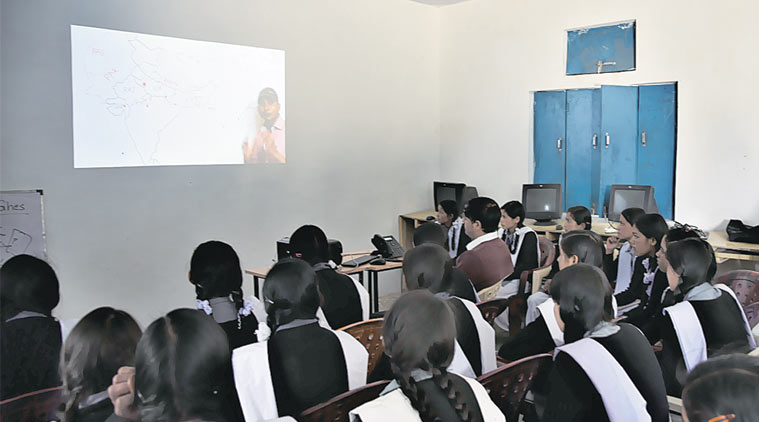 Students attend an e-lecture in Ghes, Uttarakhand
Students attend an e-lecture in Ghes, Uttarakhand
INSIDE Government Inter College in Uttarakhand’s picturesque Ghes village, a group of Class XII students is busy taking notes as a projector beams a Geography lecture in Hindi that is being downloaded from the Internet.
At a speed of 20 Mbps, the lecture rolls out smoothly on the front wall of the newly whitewashed room. For remote Ghes, tucked in the Garhwal hills, where electricity is still an aspiration and the mobile network is patchy at best, the new WiFi system that runs on solar power is “nothing less than a dream”, say residents.
On March 13, when WiFi connectivity was first established in the inter college, Class XII student Lakshman Ram rushed home to tell his mother about it. “I couldn’t understand what he was saying,” says Dimti Devi, 54. “I know nothing about WiFi and Internet. But my son told me that the school will be holding lectures for students on the Internet.”
For college teacher, Kesawanand Goswami, WiFi means a sigh of relief. “Class XI and XII students must be taught by lecturers but we have only one – for Hindi. Subjects such as Economics, Political Science, Geography, and English are not taught. Now we have started using the Internet to compensate for the lack of teachers,” says Goswami.
An hour before the Geography lecture, the 27 students had attended a lecture on Economics, with teacher Kailash Pant addressing them from Didihat in Pithoragarh district, 200 km away.
“I don’t want to miss any of the e-lectures. Hopefully, such lectures will be conducted for other subjects too,” says Kala Negi, a 17-year-old Class XII student, who walks 8 km to reach school from Himni village every day.
According to Amit Sinha, director, Information Technology Development Agency (ITDA), it was in January that the state government agency “adopted” Ghes. Set up in 2005 to accelerate the use of IT across the state, the ITDA has connected two villages so far — Ghes and Himni. “Providing WiFi connectivity to remote villages in Uttarakhand is something that we, at ITDA, consider essential,” says Sinha.
On February 15, a six-member State Wide Area Network (SWAN) team travelled 300 km from Dehradun to Ghes, which was then covered in snow, to survey the area for “any possibility” of setting up WiFi connectivity.
“Ghes was still 12 km away and the mobile phone signals dropped to zero,” says Sanjeev Sharma, project manager of SWAN in Uttarakhand.
However, a bigger challenge awaited the team: Ghes was 30 km from the last electrified village. “We didn’t know where to start. Ghes was a synonym for every hurdle that could come in the way of establishing Wi-Fi connectivity,” says Sharma.
In the absence of hotels or government quarters, residents of Himni provided accommodation to the SWAN team. Within a month, with a budget of Rs 34 lakh, four RF antennas were set up — at Tharali, Ghaniyaldhar, Himni and Ghes — along with solar panels and 2 KVA inverters in Ghes and Himni.
Then came the computer and projector at the Ghes college. And finally, in the second week of March, Ghes came online with WiFi becoming available for all 702 residents within a 200m radius of the college.
“The biggest challenge was to pick a village that was backward and make the attempt successful…but we took the risk. After Ghes, many MLAs have been contacting us to develop smart villages in their constituencies. We are working on the proposals,” says Sinha.
In Ghes, 14-year-old Chandan Ram walks uphill, passing through narrow lanes lined with traditional Garhwali houses with small wooden doors and stone-slate roofs. After about 200m, he catches a Wi-Fi signal on the smartphone borrowed from his elder sister.
The Class X student quickly types a line from his syllabus, “Sansaadhan evam vikas (resources and development)” on Google. Several options appear on screen before Ram opts for a 21-minute lecture on YouTube. “Achha samajh mein aa gaya iss video se (after watching the video, I now understand the topic quite well),” he says.
About 500m further uphill, at a makeshift dhaba, four men seated around a smartphone wait for their turn to make a move on Ludo. “The WiFi within 100m of our primary school is quite good, but signals are weak beyond that limit. Sometimes, due to bad weather, the solar panels receive no sunlight making connectivity unavailable,” complains one of them, Khadak Singh Bisht, 40, a teacher at the school.
After WiFi was established, students were shown a Garhwali film called “Kafal (a fruit)”.
Says Nima Bisht, 13: “We watched the film on the projector. The images were life-size. I was thrilled… I’ve never seen a film in the cinema hall, but I think it would be similar to what we saw on the projector, no?”